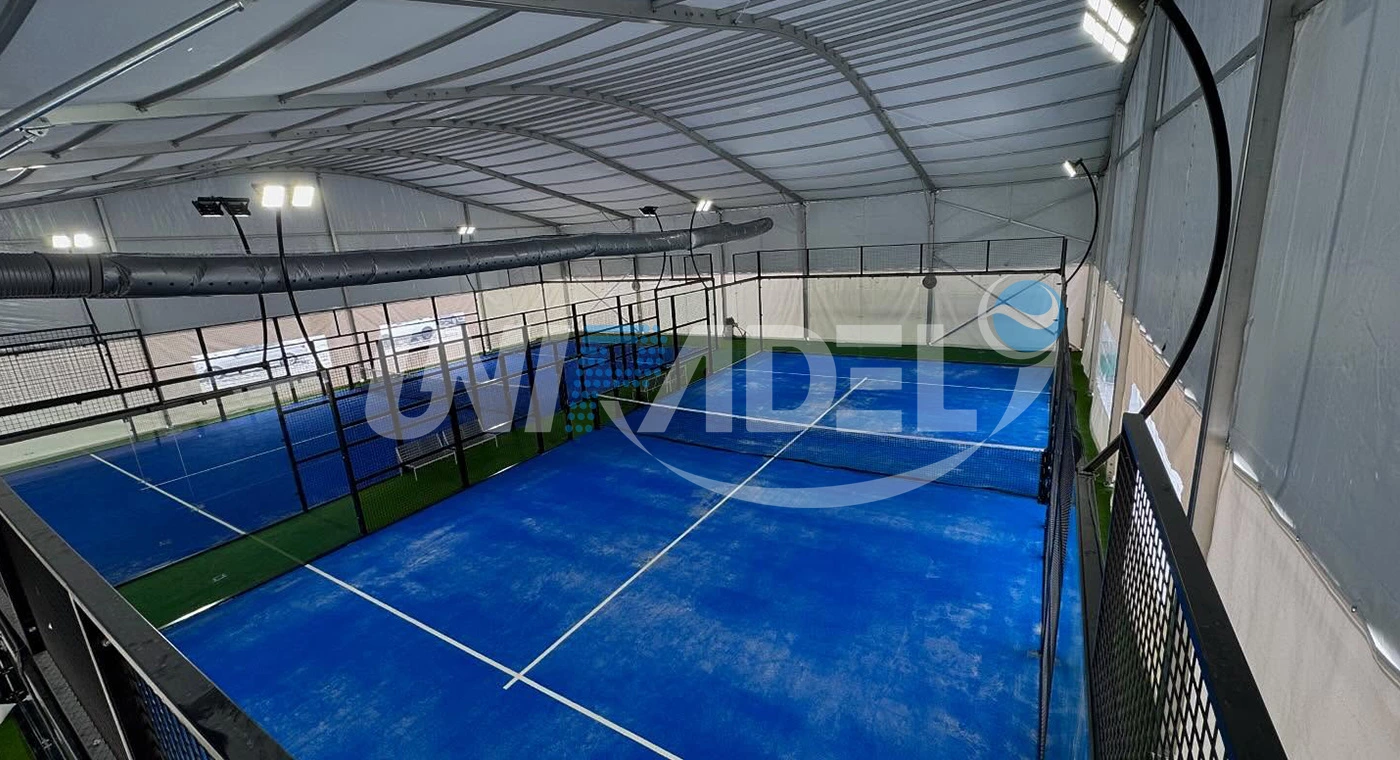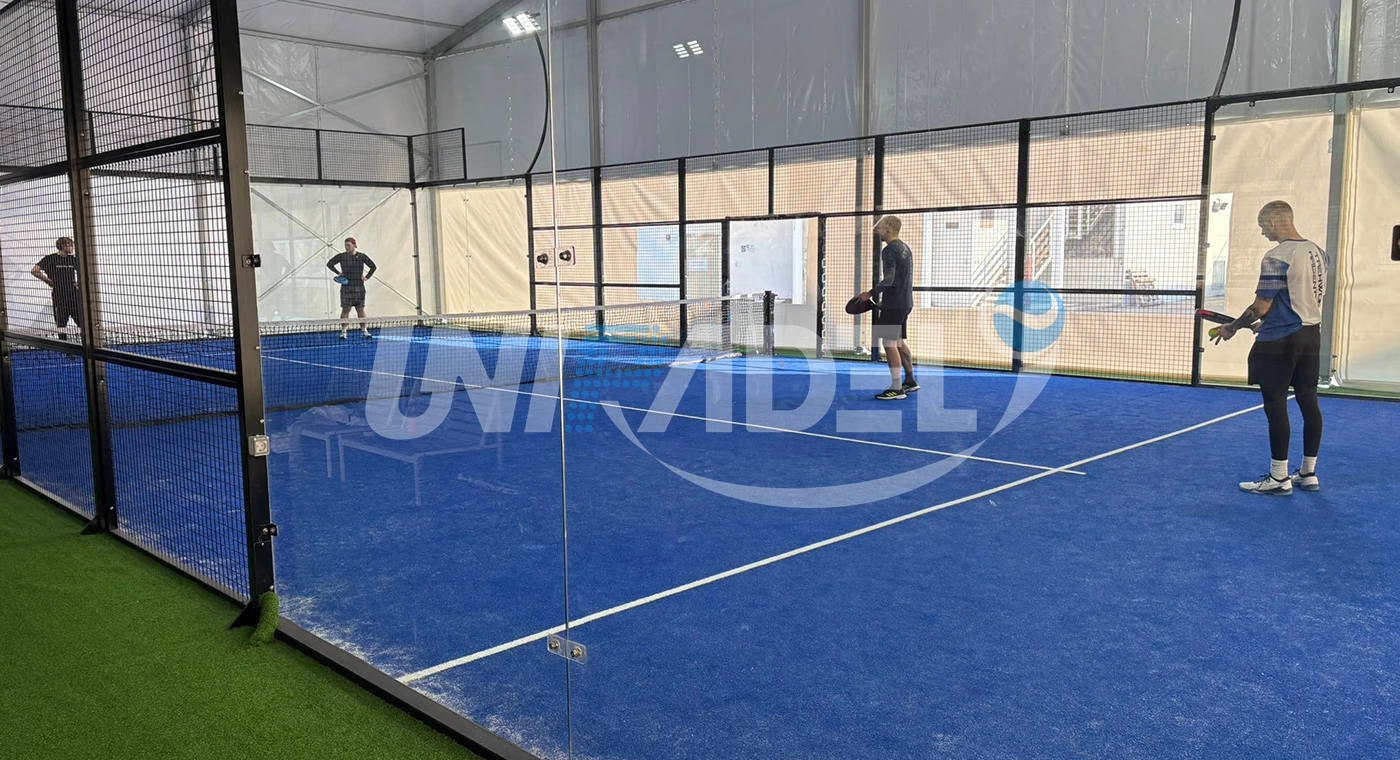Padel Courts with Separated Roof in Europe
Classic color padel court landed in European village
In a quiet village in Europe, UNIPADEL successfully installed two sets of padel courts with the most classic colors. These courts not only provide professional sports venues for local residents who love padel, but also become a new landmark for socializing and fitness in the area.
Classic blue, professional experience
The court uses the most popular blue lawn with a black frame design. This color scheme not only meets international competition standards, but also provides an excellent visual experience, allowing players to track the trajectory of the ball more clearly. In addition, the black fence around the court enhances the stability of the overall structure and ensures the safety of the players.
Separated padel court roof, all-weather protection
The customer specifically chose a separated padel roof to adapt to the local changeable climate. This structure can not only block rain and strong sunlight, but also maintain air circulation, allowing players to enjoy the game in a comfortable environment. An efficient LED lighting system is also installed inside the roof, allowing the court to continue to be used at night, providing more exercise time for villagers.
Promote the development of padel sports in the local area
Padel is developing rapidly in Europe, and the new court in this village will undoubtedly attract more people to participate in this sport. Whether you are a beginner or an experienced player, you can have fun here. Community members have said that the construction of these courts has not only enriched their daily lives, but also promoted interaction and connection between neighbors.
Why do European customers prefer indoor padel courts?
As padel becomes increasingly popular in Europe, more and more clubs and investors choose to build indoor padel courts instead of outdoor venues. This trend is not accidental, and there are clear environmental reasons and business logic behind it.
1. Europe's changeable climate is not conducive to year-round outdoor sports
Most parts of Europe have a distinct four-season and rainy climate. Countries like the United Kingdom, the Netherlands, Germany, Belgium, etc. have an average of 100-200 days of rainfall per year, which makes outdoor courts frequently unusable. In addition, the winter is long and cold, with short sunshine hours and low temperatures, which greatly reduces the outdoor sports experience.
In contrast, indoor venues can operate around the clock and are not affected by weather, providing clubs with a more stable operating cycle and income guarantee.
2. Better user experience and sports comfort
Indoor padel courts are usually equipped with LED lighting systems, constant temperature environments and professional non-slip floors to provide players with a consistent and comfortable playing experience. The court covering material provided by UNIPADEL is PVC. Whether it is hot summer or cold winter, players can exercise under ideal conditions to avoid injuries due to cold weather or wet ground.
For high-end clubs, providing a high-quality experience is the key to attracting and retaining members, and indoor venues just meet this need.
3. Extend the service life of the court and reduce maintenance costs
In the humid and rainy environment of Europe, outdoor courts are susceptible to rain erosion, aging of the lawn or corrosion of the glass, and maintenance is frequent and costly. Indoor courts are less affected by the natural environment, the structure and lawn have a longer life, and the later maintenance costs are more controllable.
From the perspective of long-term investment returns, although the initial indoor construction cost is slightly higher, the later stable income and low maintenance expenses are often more attractive.
4. Meet the needs of year-round membership operations and course arrangements
In addition to providing free play services, many European Padel clubs also offer year-round training courses, youth training camps and membership competitions, which requires the court to have high-frequency and stable use capabilities.
Indoor venues allow operators to avoid canceling courses or competitions due to weather, ensuring coach scheduling and commercial benefits, and also improving customer satisfaction and loyalty.
5. It is easier to build a multifunctional sports center
Many modern sports facilities in Europe tend to build one-stop indoor sports complexes, combining padel with gyms, cafes, saunas or changing areas to create a complete social and sports experience.
The construction of indoor courts is more convenient to combine with other facilities, improve the yield per unit area, and enhance the commercial value of the space.


